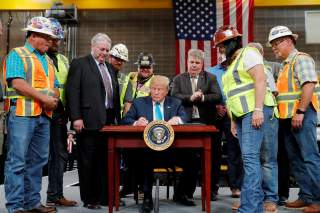Energy Innovation Will Define the 21st Century
Energy innovation could have considerable multiplier effects for both America’s prosperity and its military capabilities.
Moreover, a successful diplomatic resolution of the ongoing U.S.-China trade war seems unlikely to erase competitive tensions. U.S.-China competition has intensified over more than a decade, perhaps most dramatically in the wake of America’s 2007–2008 financial crisis, when Beijing appeared to become increasingly confident that America had begun a long-term decline and became more assertive. Indeed, from this perspective, a strong and innovative U.S economy may be among the most effective instruments of deterrence—it refutes the narrative that America is in decline, reinforces multiple dimensions of U.S. soft power and demonstrates the country’s ability to sustain a highly capable military force into the future—something that discourages rivals and reassures allies.
Yet while advocates of energy innovation may welcome U.S.-China competitive pressures as a force for bipartisan cooperation in an area of national consequence, the escalating competition between Washington and Beijing may have some undesirable implications too.
Most important, though robust competition can produce many benefits, unregulated competition among great powers can end quite badly. U.S. leaders should embrace competition as a call to action but should also take great care to avoid its darker forms. Allowing a U.S.-China trade war to produce a global economic crisis or, for that matter, allowing disputes in the South China Sea or elsewhere to produce a large-scale armed conflict, could be extremely costly. When possible, U.S. officials should continue to explore cooperation.
Intensifying U.S.-China competition in energy technology may be especially problematic for international cooperation to stop climate change. Combating climate change at the international level doesn’t necessarily require global treaties, however much some may want them, but does require the easy movement of investment and technology across national boundaries and especially into China, whose carbon dioxide emissions from energy consumption were nearly double America’s in 2016, according to the U.S. Energy Information Agency. If the United States bans or limits Chinese energy technologies from “critical” areas in its domestic energy infrastructure and presses its allies to do the same (Washington is already discouraging governments from using Huawei 5G cellular systems), the free flow of investment and technology around the world seems likely to suffer. If these approaches take root, one could even imagine two rival technology blocs, each with its own standards and supply chains. Many governments would likely be loath to choose sides—and forcing them to do so could backfire, especially if China’s government did not attempt to discourage those buying its products from using America’s too. Whatever happens, the prospects for cooperative U.S.-China energy and climate research programs may dim, and soon.
Regardless of how U.S.-China relations may turn out, however, global energy markets are set to evolve substantially in the coming decades. The task for the Trump administration, and for Congress, is to ensure that the United States continues to innovate in ways that place America at the forefront of global energy development and transformation. That will help to bolster growth, increase competitiveness and guarantee the nation’s long-term security.
Paul J. Saunders is chairman and president of the Energy Innovation Reform Project and a member of the Center for the National Interest’s board of directors.
Image: Reuters

